|
Getting your Trinity Audio player ready...
|
Teens love of picture-based apps, smart speaker growth, 41% of programmatic ads are non-viewable, and more
This is the third in our new monthly series offering the most important data and research about the media and communications industries.
Here’s 10 key numbers from the past month which caught our eye:
1: 25% of US Teen Spending is on Internet and Interactive Entertainment
The 36th semi-annual Taking Stock With Teens report from the investment bank and asset management firm Piper Jaffray, featured findings from a survey of 8,600 teens across 48 states with an average age of 16.
One key conclusion from their research is the dominance of Netflix. “Teens spend 38% of their daily video consumption on Netflix,” the report notes, “well ahead of runner up YouTube at 33% and Cable/Sat TV at 16%.”
Other notable data points included:
- Amazon is 47% of teens’ favorite website,
- Prime adoption is at 74%, up from 66% last year.
- 86% of teens anticipate their next phone will be an iPhone
Social media usage is dominated by picture based apps. Teens usage of – and a preference for – Instagram and Snapchat towers over other social networks. Meanwhile, the abandonment of Facebook by this demographic, outlined earlier this year, continues.
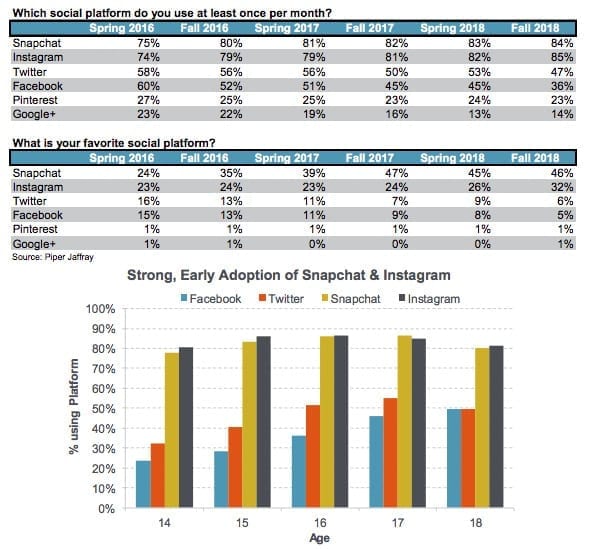
2: 56% of US consumers think cable TV is too expensive
Highlighting a strategic problem for the old media guard, a national tracking poll from the Hollywood Reporter and Morning Consult found that large numbers of consumers felt that both cable and satellite TV was too expensive; a key driver for cord cutting,
Overall, 56% of their sample determined that cable TV was “not too affordable” or “not affordable at all,” with 47% expressing similar sentiments about satellite television.
In contrast, only 17% expressed this concern about streaming service, with 68% determining that these products were either “very affordable” or “somewhat affordable.”
Earlier this year, eMarketer predicted that 33 million adults have already cut the cord. This is expected to reach 55.1 million (nearly 21% of the US adult population) by 2022.
Americans “ subscribe to an average of three on-demand streaming services. That translates to collective monthly spending of $2.1 billion by US households on these services—and this figure keeps growing,” Deloitte’s 2018 Digital Media Trends Survey previously concluded.
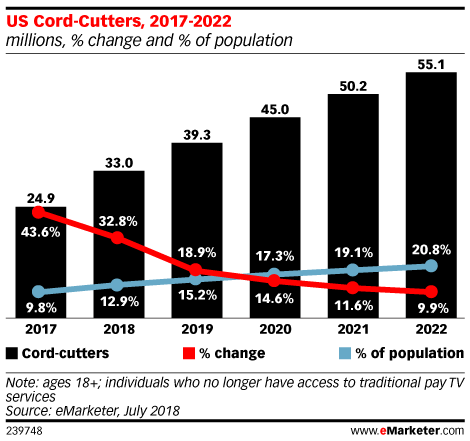
3: 83.6% of US digital display ad dollars will be programmatic next year
That’s the standout stat from a new comScore webinar on Ad Targeting in the Age of Privacy. Citing data from eMarketer, the presentation also stated that:
- Programmatic ad spend in the US this year will be c. $46 billion
- The market is expected to add another $19 billion between 2018-2020.
However, they cautioned, “In many markets, less than half of ads are delivered in-target,” and “viewability and IVT [Invalid traffic] can derail a campaign before it starts.”

4: Amazon is now the third-largest digital advertising platform
“Ads are Amazon’s fastest-growing segment, climbing 123 percent year over year,” Garett Sloane wrote in Ad Age.
The company garnered $2.5 billion in sales last quarter, making it the third largest digital advertising platform in the U.S. after Facebook and Google. eMarketer predicts that “US advertisers will spend $4.61 billion on Amazon’s platform this year.”
“Amazon has been experimenting with new formats, like video ads that appear in product listings,” Sloane noted, with advertisers using “ Amazon as a place to reach shoppers when they are conducting their product searches.”
In taking the No. 3 slot, Amazon has overtaken Microsoft and Oath (Verizon). Nonetheless, with 4.1% of the digital ad market, Amazon still has a long way to go before catching up with Facebook (20.6% share) or Google (37.1%).
5: U.S. Smart Speaker ownership hits 57 Million
A new survey by Voicebot.ai concluded that 23% of U.S. adults now own a smart speaker. Ownership of products like Amazon Alexa, Google Home, or Apple HomePod has grown +22% since January 2018.
“This is significant,” Bret Kinsella wrote, “in part because the rate of smart speaker adoption does not appear to be slowing much even as the user base grows. And, this rise in smart speaker users is prior to the fourth quarter holiday shopping season when more than 50% of annual devices sales have taken place the past two years.”
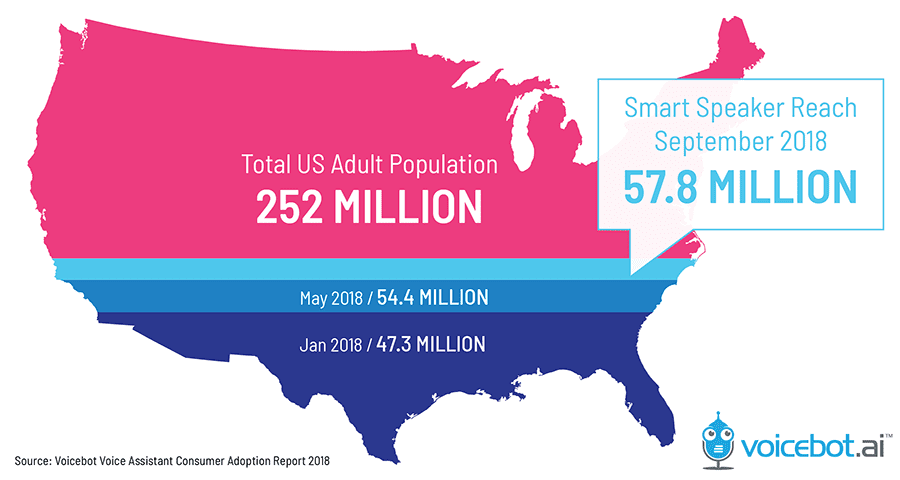
6: 52% of mobile consumers in Asia-Pacific use voice assistants
“Voice search growth is being driven by the key Asian markets, with India, China and Indonesia coming out on top,” wrote Olivia Valentine on the GlobalWebIndex blog.
“These consumers’ introduction to the internet is likely to be via smartphone, so the importance of integrated voice assistants, alongside frequent upgrade cycles, shouldn’t be underestimated,” she said.
The latest wave of research from the firm’s global tracker revealed that: “Just under half of online adults are now using voice technology in some way – whether that’s through voice assistants on smartphones, or smart home assistants.”
Noting “significant growth in uptake” the research also found Europeans were the least likely to use this technology.
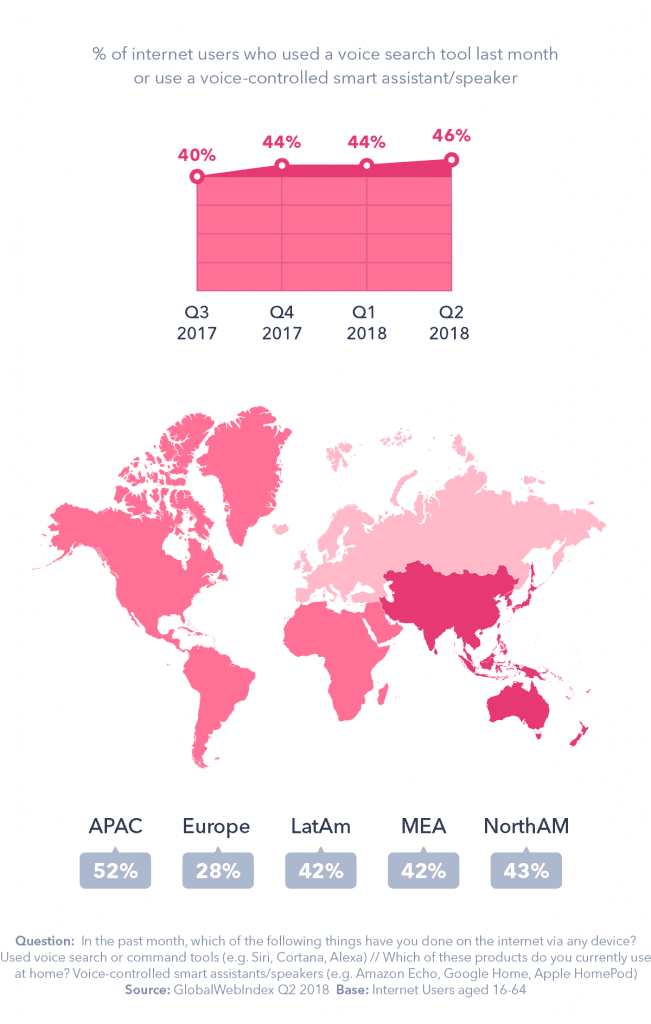
7: Radio reaches more Americans each week than any other platform
This was the conclusion from Nielsen’s Audio Today 2018 report. Commenting that “for audio, the golden age is upon us,” the company highlighted how technology also makes it easier and easier to listen to radio content.
“Powered by dozens of networks and syndicators which supply programming to thousands of stations, network radio has something for everyone,” Nielsen wrote. “The data backs this up, as 94% of all radio listeners nationwide tune to a network affiliated station every week.”
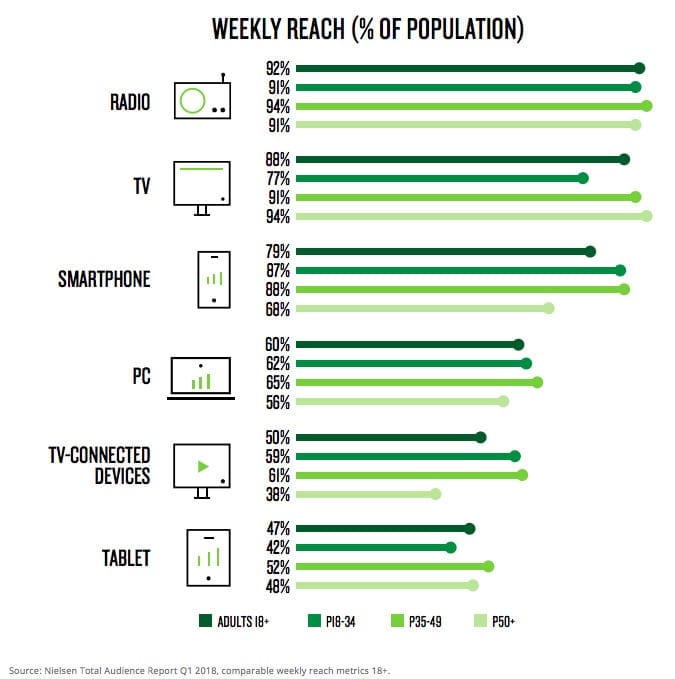
8: Around 500,000 Google+ users had private information leaked
Google revealed in a blog post last month that it will be shutting down its Google + social network, following a data breach.
As Nick Statt in The Verge explained, “Google+ profile information like name, email address, occupation, gender, and age were exposed, even when that data was listed as private and not public.“
Google’s admission of this, also included an acknowledgement that the service had never really taken off. “…While our engineering teams have put a lot of effort and dedication into building Google+ over the years, it has not achieved broad consumer or developer adoption, and has seen limited user interaction with apps,” they wrote.
“The consumer version of Google+ currently has low usage and engagement: 90 percent of Google+ user sessions are less than five seconds.”
The consumer version of Google + will close in August 2019. A version for corporate customers will continue.
9: Tech adoption plateaus in the U.S. among 18-49 year olds
Take-up of many digital technologies in the States has levelled off, data from the Pew Research Center observed.
“A contributing factor behind this slowing growth is that parts of the population have reached near-saturation levels of adoption of some technologies,” they not. “Put simply, in some instances there just aren’t many non-users left.”
“A canvassing of experts by the Center suggested that it might make sense in the near future to stop asking people if they “use the internet” because it will be so ubiquitous,” researcher Paul Hitlin commented.
“Those experts predicted that the internet would become “like electricity” – almost invisible to users, yet more deeply embedded in their lives.”
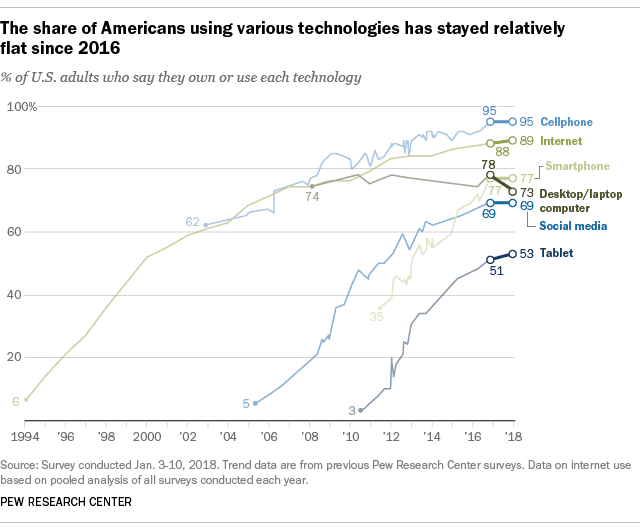
10: Only 1% of tweets hitting the 280-character limit
According to new data released by Twitter this month, only 1% of tweets hit the (newish, it’s now one year-old) 280-character limit.
Just 12% of tweets are longer than the previous 140- character limit.
“Brevity, it seems, is baked into Twitter,” Sarah Perez wrote over at TechCrunch, “even when given expanded space, people aren’t using it.”
“Only 5% of tweets are longer than 190 characters, she wrote, “indicating that Twitter users have been for so long trained to keep their tweets short, they haven’t adapted to take advantage of the extra room to write.”
Seen a stat or research paper worth sharing? Tweet us @wnip


